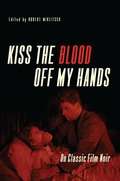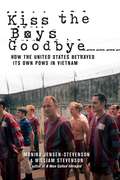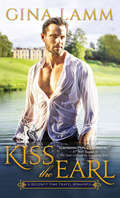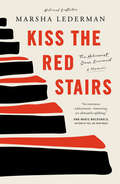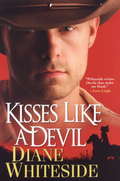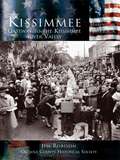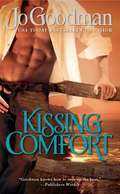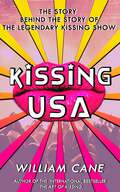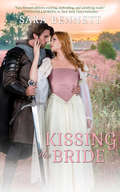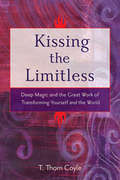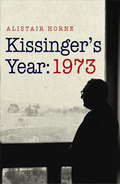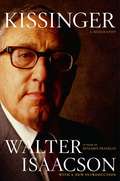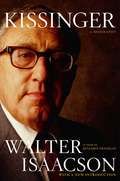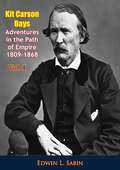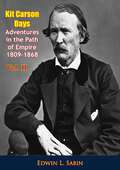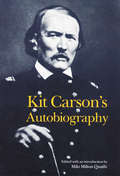- Table View
- List View
Kiss the Blood Off My Hands: On Classic Film Noir
by Robert MiklitschConsider the usual view of film noir: endless rainy nights populated by down-at-the-heel boxers, writers, and private eyes stumbling toward inescapable doom while stalked by crooked cops and cheating wives in a neon-lit urban jungle. But a new generation of writers is pushing aside the fog of cigarette smoke surrounding classic noir scholarship. In Kiss the Blood Off My Hands: On Classic Film Noir, Robert Miklitsch curates a bold collection of essays that reassesses the genre's iconic style, history, and themes. Contributors analyze the oft-overlooked female detective and little-examined aspects of filmmaking like love songs and radio aesthetics, discuss the significance of the producer and women's pulp fiction, as well as investigate Disney noir and the Fifties heist film, B-movie back projection and blacklisted British directors. At the same time the writers' collective reconsideration unwinds the impact of hot-button topics like race and gender, history and sexuality, technology and transnationality. As bracing as a stiff drink, Kiss the Blood Off My Hands writes the future of noir scholarship in lipstick and chalk lines for film fans and scholars alike.
Kiss the Boys Goodbye: How the United States Betrayed Its Own POWs in Vietnam
by William Stevenson Monika Jensen-StevensonThe classic account of the abandonment of American POWs in Vietnam by the US government.For many Americans, the recent conflicts in Iraq and Afghanistan bring back painful memories of one issue in particular: American policy on the rescue of and negotiation for American prisoners. One current American POW of the Taliban, Sergeant Bowe Bergdahl, stands as their symbol. Thousands of Vietnam veteran POW activists worry that Bergdahl will suffer the fate of so many of their POW/MIA comrades-abandonment once the US leaves that theater of war.Kiss the Boys Goodbye convincingly shows that a legacy of shame remains from America's ill-fated involvement in Vietnam. Until US government policy on POW/MIAs changes, it remains one of the most crucial issues for any American soldier who fights for home and country, particularly when we are engaged with an enemy that doesn't adhere to the international standards for the treatment of prisoners-or any American hostage-as the graphic video of Daniel Pearl's decapitation on various Jihad websites bears out.In this explosive book, Monika Jensen-Stevenson and William Stevenson provide startling evidence that American troops were left in captivity in Indochina, victims of their government's abuse of secrecy and power. The book not only delves into the world of official obstruction, missing files, censored testimony, and the pressures brought to bear on witnesses ready to tell the truth, but also reveals the trauma on patriotic families torn apart by a policy that, at first, seemed unbelievable to them.First published in 1990, Kiss the Boys Goodbye has become a classic on the subject. This new edition features an afterword, which fills in the news on the latest verifiable scandal produced by the Senate Select Committee on POWs.
Kiss the Earl
by Gina LammA modern girl's guide to seducing Mr. DarcyWhen Ella Briley asked her lucky-in-love friends to set her up for an office party, she was expecting a blind date. Instead, she's pulled through a magic mirror and into the past...straight into the arms of her very own Mr. Darcy. Patrick Meadowfair, earl of Fairhaven, is too noble for his own good. To save a female friend from what is sure to be a loveless marriage, he's agreed to whisk her off to wed the man she truly wants. But all goes awry when Patrick mistakes Ella for the would-be bride and kidnaps her instead.Centuries away from everything she knows, Ella's finally found a man who heats her blood and leaves her breathless. Too bad he's such a perfect gentleman. Yet the reluctant rake may just find this modern girl far too tempting for even the noblest of men to resist...
Kiss the Red Stairs: The Holocaust, Once Removed
by Marsha LedermanFor readers of All Things Consoled by Elizabeth Hay and They Left Us Everything by Plum Johnson, Kiss the Red Stairs is a compelling memoir by award-winning journalist Marsha Lederman delves into her parents&’ Holocaust stories in the wake of her own divorce, investigating how trauma migrates through generations with empathy, humour, and resilience.Marsha was five when a simple question led to a horrifying answer. Sitting in her kitchen, she asked her mother why she didn&’t have any grandparents. Her mother told her the truth: the Holocaust.Decades later, her parents dead and herself a mother to a young son, Marsha begins to wonder how much history has shaped her own life. Reeling in the wake of a divorce, she craves her parents&’ help. But in their absence, she is gripped by a need to understand the trauma they suffered, and she begins her own journey into the past to tell her family&’s stories of loss and resilience.Kiss the Red Stairs is a compelling memoir of Holocaust survival, intergenerational trauma, divorce, and discovery that will guide readers through several lifetimes of monumental change.
Kiss ’Em Goodbye: An ESPN Treasury of Failed, Forgotten, and Departed Teams
by Dennis PurdyTHEY'RE GOING, GOING, GONE. . . . Their names roll off the tongue, a litany of the damned: the Providence Steam Roller, the Wilmington Quicksteps, the Cincinnati Porkers. They are the lost squads of professional sports history-teams forsaken by fans, fleeced by owners, or forgotten by time. Until now. Kiss 'Em Goodbyeunearths the real stories of dozens of vanished teams that once graced-and often disgraced-North America's big leagues. Like the St. Paul Apostles, the only major league team ne...
Kissed by Shadows (The Kiss Trilogy)
by Jane FeatherNew York Times bestselling author Jane Feather has won legions of fans and critical accolades for her unique blend of sizzling seduction, dangerous intrigue, and passionate adventure. In this second of two romances featuring two unconventional sisters whose quest to solve the mystery surrounding their lives puts each of them in the path of an irresistible hero, Jane Feather tells the story of a young bride in peril and a mysterious English lord who find themselves at the center of a sinister plot...and a reckless affair.Kissed By ShadowsLady Philippa Nielson had no memory of what took place in her bedchamber in the dead of night--nor knowledge of the dangerous plot that put her life in jeopardy. But with a brief touch of his hand and one glance of his knowing gray eyes, Pippa felt a connection to the dark stranger who should have been her greatest enemy. Who was this man who seemed to understand more about her life than she did herself? Why did she respond to his most casual caresses with the most urgent and reckless of desires? Lionel Ashton had been appointed guardian of both Pippa and the secret she unknowingly bore. And protect this sensuous and fiercely independent woman he would, even from the king himself. But what Lionel knows about Pippa will put both their lives in the greatest danger--even as they slip under the spell of a daring seduction that will turn them into passionate outlaws...and legendary lovers.
Kisses Like A Devil
by Diane WhitesideHis wicked desire could free her. . . Strikingly handsome, wealthy, and accomplished, Brian Donovan has succeeded in everything he puts his mind to--except marriage. Now, as a favor to his former military commander Teddy Roosevelt, Brian is investigating a powerful new weapon invented in the small European country of Eisengau. The task carries prestige, danger, and an enticing complication in the lithe form of Meredith Duncan. With her deliciously candid approach to all things sensual, Meredith is unlike any woman Brian has known. In fact, she wants him to ruin her reputation--and Brian eagerly obliges, initiating a passionate, playful, and wildly erotic affair. . . Or enslave her. . . A feminist who believes in free love, Meredith has always battled convention. When her parents urge her toward an odious marriage, Meredith turns to the dashing, thoroughly masculine American who could be her only hope of escape. But nothing is as simple as it seems, and as competition to acquire the new weapon turns deadly, two lovers are drawn into a treacherous game where the stakes run as high as their raw, mutual desire, and the greatest risk of all may lie within an untested and all-consuming love. . .
Kisses, She Wrote
by Katharine AsheChristmas in town has never been so steamy . . . Handsome as sin and scandalously rakish, Cam Westfall, the Earl of Bedwyr, is every young lady's wickedest dream. Shy wallflower Princess Jacqueline of Sensaire knows this better than anyone, because her dreams are full of the breathtaking earl's kisses. And not only her dreams--her diary, too. But when Cam discovers the maiden's not-so-maidenly diary, will her wildest Christmas wishes be fulfilled in its pages . . . or in his arms?
Kissimmee: Gateway to the Kissimmee River Valley
by Jim Robison Osceola County Historical SocietyKissimmee, Florida traces its name to the Jororo tribe, among the first to settle along the river valley. Riverboat captains, entrepreneurs, and speculators found Kissimmee and nearby Lake Tohopekaliga irresistible, and soon settlers followed. The 1880s marked this city's first brush with tourism, as the Tropical Hotel became the largest resort hotel south of Jacksonville. As the cattle town struggled to survive floods, the Depression, and downtown neglect in favor of spillover Walt Disney World business, committed citizens fought back and spiritedly rekindled the town into a favored tourist spot.
Kissing Comfort
by Jo GoodmanBode DeLong knows that his playboy brother Bram isn't really in love with Miss Comfort Kennedy, even though it's clear that she's enamored with him. With Bram's motives for the engagement suspect, Bode figures the safest place for Comfort to be is in his arms. Now, Bode just needs to convince Comfort that the childhood fancy she has for his brother is no match for the incredible desire that sparks between them every time they touch.
Kissing Shakespeare
by Pamela MingleA romantic time travel story that's ideal for fans of novels by Meg Cabot and Donna Jo Napoli--and, of course, Shakespeare.Miranda has Shakespeare in her blood: she hopes one day to become a Shakespearean actor like her famous parents. At least, she does until her disastrous performance in her school's staging of The Taming of the Shrew. Humiliated, Miranda skips the opening-night party. All she wants to do is hide. Fellow cast member, Stephen Langford, has other plans for Miranda. When he steps out of the backstage shadows and asks if she'd like to meet Shakespeare, Miranda thinks he's a total nutcase. But before she can object, Stephen whisks her back to 16th century England--the world Stephen's really from. He wants Miranda to use her acting talents and modern-day charms on the young Will Shakespeare. Without her help, Stephen claims, the world will lost its greatest playwright. Miranda isn't convinced she's the girl for the job. Why would Shakespeare care about her? And just who is this infuriating time traveler, Stephen Langford? Reluctantly, she agrees to help, knowing that it's her only chance of getting back to the present and her "real" life. What Miranda doesn't bargain for is finding true love . . . with no acting required.From the Hardcover edition.
Kissing USA: The Story Behind the Story of The Legendary Kissing Show
by William CaneCollege. For many, it is a place of learning, self-discovery, and growth. But as much as parents don't want to admit it, college is also a time of unabashed exploration, especially for the MTV-drenched and Howard Stern Radio Show-soaked kids of the 1990s. So, it makes perfect sense that The Kissing Show, a performance based on the international bestseller The Art of Kissing, became a near-overnight sensation.Born out of William Cane's Judd Apatow-like desire to woo the woman of his dreams, The Kissing Show appeared at over 400 colleges and universities across the nation.Kissing U.S.A. reveals it all in a sexy (and sometimes shocking) behind-the-scenes look at all the things that were part of making the The Kissing Show a sensation:The comedic and surprising foibles of Cane's own love lifeThe power of listening to and understanding your audienceDealing with competition from drag queensThe importance of having a "less-than-ideal" museThe fact that almost anything can be a source of inspiration--if spun the right wayJoin Cane as he recounts his meteoric rise in the college lecture and entertainment circuit through all the good, the bad, and the awkward kisses that took North American colleges by storm. Who knew playing dentist could ever be a turn-on?
Kissing Under the Mistletoe
by Suzanne Enoch Amelia Grey Anna BennettFrom the Scottish highlands, to the bustle and tussle of London, to a hotel on the outskirts of town, three unforgettable authors bring the joy of Christmas romance in Kissing Under the Mistletoe.Great Scot! by Suzanne EnochMiss Jane Bansil knows she will never have a fairy-tale moment. Well past the marriageable age, she’s taken a position as a companion and is now stuck in Scotland for Christmas, alone even in the middle of the boisterous MacTaggert family. But when Brennan Andrews, an architect and cousin to the MacTaggerts, arrives to draw up plans for a new family home, Jane must decide if she will take a chance at a happily-ever-after, or settle into her small, safe life for good.Christmas at Dewberry Hollow by Amelia Grey Miss Isabelle Reed has no plans to ever fall in love. She has a perfectly acceptable life with her mother at the Dewberry Hollow Inn, thank you very much. But when Gate, the Duke of Notsgrave’s grandson, appears at Dewberry Hollow searching for a carving on a tree, Isabelle cannot help but get involved. But Gate’s charm and their instant attraction makes Isabelle question if she’s willing to take her chance at love once again.My Mistletoe Beau by Anna BennettMiss Eva Tiding is determined to cheer her widowed father with the perfect Christmas gift. Even if it means breaking into the home of the rakish Earl of Frostbough who swindled Papa out of his pocket watch. But when the earl, Jack Hardwick, catches her in the act, they strike a deal: she’ll pose as his fiancée in exchange for the watch. Falling in love is not part of the plan—but with a little Christmas magic, anything is possible…
Kissing the Bride
by Sara BennettAn Unexpected PassionYoung widow, Lady Jenova of Gunlinghorn knows she must marry again, but is unsure of the bridegroom that has been chosen. However, she knows she can trust her devilishly handsome childhood friend, Lord Henry, who now advises the King! When they are trapped together by a winter tempest, she and Henry shock themselves by surrendering to a wildly passionate indiscretion. And suddenly Jenova must rethink her wedding plans…“Sara Bennett is one of today’s most gifted romance writers. She writes with passion and truly gets into the ‘heads’ of her characters making them come to life for all of us to enjoy.”—Joyfully Reviewed“Bennett gets this true-to-life tale of medieval life exactly right.”—>i?Romantic Times
Kissing the Limitless: Deep Magic and the Great Work of Transforming Yourself and the World
by T. Thorn CoyleThis book was written to be used in concert with whatever pagan tradition you are currently involved in. There are at least three levels to it: part one will help you strengthen the foundations of your spiritual practice, part two will ensure that you are sound in body, mind, emotion, sex, and spirit, and have developed will and ethics, and part three will lead you further into connection with your Godhood. . . The tools used to do this are breath work, dream work, pendulum work, aura reading, tarot, meditation, spells, and others. The goal of the book is to help guide you through the stages of personal consciousness that will then enable you to step into inclusive consciousness—a consciousness that encompasses the personal, political, environmental, social, mental, and transpersonal. [It is this] inclusive consciousness [that] enables us to reach the limitless, the divine, Goddess or God.
Kissinger
by Niall FergusonThe definitive biography of Henry Kissinger, based on unprecedented access to his private papersNo American statesman has been as revered or as reviled as Henry Kissinger. Once hailed as "Super K"--the "indispensable man" whose advice has been sought by every president from Kennedy to Obama--he has also been hounded by conspiracy theorists, scouring his every "telcon" for evidence of Machiavellian malfeasance. Yet as Niall Ferguson shows in this magisterial two-volume biography, drawing not only on Kissinger's hitherto closed private papers but also on documents from more than a hundred archives around the world, the idea of Kissinger as the ruthless arch-realist is based on a profound misunderstanding.The first half of Kissinger's life is usually skimmed over as a quintessential tale of American ascent: the Jewish refugee from Hitler's Germany who made it to the White House. But in this first of two volumes, Ferguson shows that what Kissinger achieved before his appointment as Richard Nixon's national security adviser was astonishing in its own right. Toiling as a teenager in a New York factory, he studied indefatigably at night. He was drafted into the U.S. infantry and saw action at the Battle of the Bulge--as well as the liberation of a concentration camp--but ended his army career interrogating Nazis. It was at Harvard that Kissinger found his vocation. Having immersed himself in the philosophy of Kant and the diplomacy of Metternich, he shot to celebrity by arguing for "limited nuclear war." Nelson Rockefeller hired him. Kennedy called him to Camelot. Yet Kissinger's rise was anything but irresistible. Dogged by press gaffes and disappointed by "Rocky," Kissinger seemed stuck--until a trip to Vietnam changed everything. The Idealist is the story of one of the most important strategic thinkers America has ever produced. It is also a political Bildungsroman, explaining how "Dr. Strangelove" ended up as consigliere to a politician he had always abhorred. Like Ferguson's classic two-volume history of the House of Rothschild, Kissinger sheds dazzling new light on an entire era. The essential account of an extraordinary life, it recasts the Cold War world.
Kissinger and Brzezinski: The NSC and the Struggle for Control of US National Security
by Gerry Argyris AndrianopoulosThe factors which influenced foreign policy under Nixon and Carter.
Kissinger's Year: 1973
by Alistair HorneThe life of Henry Kissinger seen through one seminal year - 1973.1973 was a seminal year in world history. The outbreak of the 'Yom Kippur War' took both Israel and the US by surprise, the Vietnam War finally ended, it was the year of détente with the Soviet Union, but the US executive was in a state of collapse following Watergate, and the year ended with the Muslim-initiated energy crisis, which brought the Western world to the brink of economic disaster - a story of deepest relevance today.This book is the biography of Kissinger - the first he has authorised - viewed through the events of this crucial year. A story of his extraordinarily imaginative aims, his near successes, and, as he admits, his ultimate failures.
Kissinger's Year: 1973
by Sir Alistair Horne CBEThe life of Henry Kissinger seen through one seminal year - 1973.1973 was a seminal year in world history. The outbreak of the 'Yom Kippur War' took both Israel and the US by surprise, the Vietnam War finally ended, it was the year of détente with the Soviet Union, but the US executive was in a state of collapse following Watergate, and the year ended with the Muslim-initiated energy crisis, which brought the Western world to the brink of economic disaster - a story of deepest relevance today.This book is the biography of Kissinger - the first he has authorised - viewed through the events of this crucial year. A story of his extraordinarily imaginative aims, his near successes, and, as he admits, his ultimate failures.
Kissinger: A Biography
by Walter IsaacsonBy the time Henry Kissinger was made secretary of state in 1973, he had become, according to the Gallup Poll, the most admired person in America and one of the most unlikely celebrities ever to capture the world's imagination. Yet Kissinger was also reviled by large segments of the American public, ranging from liberal intellectuals to conservative activists. Kissinger explores the relationship between this complex man's personality and the foreign policy he pursued. Drawing on extensive interviews with Kissinger as well as 150 other sources, including U. S. presidents and his business clients, this first full-length biography makes use of many of Kissinger's private papers and classified memos to tell his uniquely American story. The result is an intimate narrative, filled with surprising revelations, that takes this grandly colorful statesman from his childhood as a persecuted Jew in Nazi Germany, through his tortured relationship with Richard Nixon, to his later years as a globe-trotting business consultant.
Kissinger: A Biography
by Walter IsaacsonThe definitive biography of Secretary of State Henry Kissinger and how his ideas still resonate in the world today from the bestselling author of Leonardo da Vinci and Steve Jobs.By the time Henry Kissinger was made secretary of state in 1973, he had become, according to the Gallup Poll, the most admired person in America and one of the most unlikely celebrities ever to capture the world's imagination. Yet Kissinger was also reviled by large segments of the American public, ranging from liberal intellectuals to conservative activists. Kissinger explores the relationship between this complex man&’s personality and the foreign policy he pursued. Drawing on extensive interviews with Kissinger as well as 150 other sources, including US presidents and his business clients, this first full-length biography makes use of many of Kissinger&’s private papers and classified memos to tell his uniquely American story. The result is an intimate narrative, filled with surprising revelations, that takes this grandly colorful statesman from his childhood as a persecuted Jew in Nazi Germany, through his tortured relationship with Richard Nixon, to his later years as a globe-trotting business consultant.
Kit
by Marina FioratoAn unforgettable historical romance based on an astonishing true story from international bestseller Mariano Fiorato - perfect for fans of Poldark and The Scandalous Lady W.Dublin 1702. Irish beauty Kit Kavanagh has everything she could want in life. Newly married, she runs a successful alehouse with her beloved husband Richard. The wars that rage in Europe over the Spanish throne seem a world away.But everything changes on the night that Richard simply disappears. Finding the Queen's shilling at the bottom of Richard's tankard, Kit realizes that her husband has been taken for a soldier.Kit follows Richard's trail across the battlefields of Italy in the Duke of Marlborough's regiment. Living as a man, risking her life in battle, she forms a close bond with her wry and handsome commanding officer Captain Ross. When she is forced to flee the regiment following a duel, she evades capture by dressing once more as a woman. But the war is not over for Kit. Her beauty catches the eye of the scheming Duke of Ormonde, who recruits her to spy upon the French. In her finery she meets Captain Ross once again, who seems just as drawn to the woman as he was to the soldier.Torn between Captain Ross and her loyalty to her husband, and under the orders of the English Crown, Kit finds that her life is in more danger now than on the battlefield.(P)2015 Hodder & Stoughton
Kit Carson Days Adventures in the Path of Empire 1809-1868 Vol. I (Kit Carson Days Adventures in the Path of Empire 1809-1868 #1)
by Edwin L. SabinChristopher Houston "Kit" Carson (December 24, 1809 - May 23, 1868) was an American frontiersman. The few paying jobs he had during his lifetime included mountain man (fur trapper), wilderness guide, Indian agent, and American Army officer. Carson became a frontier legend in his own lifetime via biographies and news articles. Exaggerated versions of his exploits were the subject of dime novels. In the 1840s, he was hired as a guide by John C. Fremont. Fremont's expedition covered much of California, Oregon, and the Great Basin area. Fremont mapped and wrote reports and commentaries on the Oregon Trail to assist and encourage westward-bound American pioneers. Carson achieved national fame through Fremont's accounts of his expeditions. Under Fremont's command, Carson participated in the uprising against Mexican rule in California at the beginning of the Mexican-American War. Later in the war, Carson was a scout and courier, celebrated for his rescue mission after the Battle of San Pasqual and for his coast-to-coast journey from California to Washington, DC to deliver news of the conflict in California to the U.S. government. During the American Civil War, Carson led a regiment of mostly Hispanic volunteers from New Mexico on the side of the Union at the Battle of Valverde in 1862.-Print ed.
Kit Carson Days Adventures in the Path of Empire 1809-1868 vol. II (Kit Carson Days Adventures in the Path of Empire 1809-1868 #2)
by Edwin L. SabinChristopher Houston "Kit" Carson (December 24, 1809 - May 23, 1868) was an American frontiersman. The few paying jobs he had during his lifetime included mountain man (fur trapper), wilderness guide, Indian agent, and American Army officer. Carson became a frontier legend in his own lifetime via biographies and news articles. Exaggerated versions of his exploits were the subject of dime novels. In the 1840s, he was hired as a guide by John C. Fremont. Fremont's expedition covered much of California, Oregon, and the Great Basin area. Fremont mapped and wrote reports and commentaries on the Oregon Trail to assist and encourage westward-bound American pioneers. Carson achieved national fame through Fremont's accounts of his expeditions. Under Fremont's command, Carson participated in the uprising against Mexican rule in California at the beginning of the Mexican-American War. Later in the war, Carson was a scout and courier, celebrated for his rescue mission after the Battle of San Pasqual and for his coast-to-coast journey from California to Washington, DC to deliver news of the conflict in California to the U.S. government. During the American Civil War, Carson led a regiment of mostly Hispanic volunteers from New Mexico on the side of the Union at the Battle of Valverde in 1862.-Print ed.
Kit Carson's Autobiography
by Kit Carson Milo Milton Quaife"Notice is hereby given to all persons, that Christopher Carson, a boy about 16 years old, small of his age, but thick-set; light hair, ran away from the subscriber, living in Franklin, Howard County, Missouri, to whom he had been bound to learn the saddler's trade. . . . One cent reward will be given to any person who will bring back the said boy.''This notice appeared in the Missouri Intelligencer of October 6, 1826, at about the same time that Kit Carson, in the humble role of "cavvy boy" in Bent's Santa Fé caravan, embarked upon his notable career. Thirty years later, a postgraduate of the University of the Wilderness, and for a decade past a national hero, he was persuaded to dictate to a literate friend his own story of his life to date.The account—as modest and undemonstrative as Carson's feats were remarkable—covers his life as a trapper, Indian fighter, guide, and buffalo hunter up to the fall of 1856. Among the high spots during these years were his trapping expedition to California with Ewing Young (1829–1831), his celebrated duel with Shunar at the Green River rendezvous of 1837, the three expeditions with John C. Frémont (1842, 1843–1844, 1845), his exploits in the Mexican War (l846–1848), and his service as an Indian agent.
